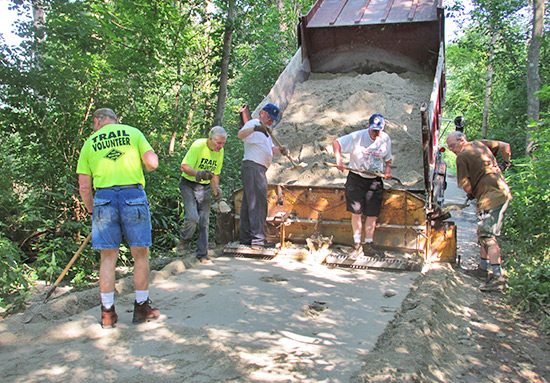Surfaces
Delaware & Lehigh Trail | Photo by Thom Carroll
When choosing a surface for your trail, consider the following:
- User acceptance and satisfaction
- Accessibility
- Cost to purchase and install materials
- Cost of maintaining the surface
- Life expectancy
- Availability of material
Before you choose a specific trail surface, you should also consider the pros and cons of hard surfaces and soft surfaces. While hard-surface trails are more accommodating, require less maintenance and can withstand frequent use, they are also significantly more expensive. On the other hand, soft-surface trails cost less, but generally do not hold up well under heavy use or varying weather conditions.

Hard Surfaces
Asphalt
Asphalt works well for bicycle commuters and inline skaters, which is a reason it is often used in urban areas. It typically can’t be used by equestrians. It also requires regular, minor maintenance such as crack patching, yet has a life expectancy of 7 to 15 years. Asphalt is a flexible surface that requires use to remain pliable and will last longer with heavy use. However, those installing asphalt should be conscious of the possibility of environmental contamination during construction.
Concrete
Concrete is usually the longest lasting of the hard surface materials, but it is also one of the most expensive. Well-maintained concrete can last 25 years or more. The surface is appropriate for urban areas with severe climate swings and a susceptibility to flooding. However, the hard surface is taxing on runners’ lower limbs, and is thus unpopular with that significant user group. Adjacent soft-surface treads can accommodate runners and equestrians where concrete is necessary for the main trail.
Crushed Stone
Crushed stone is popular as a trail surface because it holds up well under heavy use and can complement the aesthetic of the natural landscape. It can also accommodate nearly every trail user (with the exception of inline skaters) if crushed and compacted properly. Because crushed stone can be made of nearly any type of rock, including limestone and sandstone, it is one of the most accessible trail surface types.
Soil Cement
Soil cement is a mixture of pulverized native soil, Portland cement and water, rolled and compacted into very dense surface. It is cheaper than asphalt, but drainage is very important to prevent erosion.
Resin-Based Stabilized Material
Resin is a tree product that binds aggregate or soil particles together. A resin-based trail surface impacts the environment less than asphalt and can be cheaper. The aesthetics also better match the surrounding environment.
Boardwalk
Boardwalk is most often used as a trail surface for segments through wetlands, as it allows adequate drainage and impacts the fragile ecosystem less than other surface types. However, it can be slippery when wet and is quite expensive to install and maintain.
Recycled Materials
Various recycled materials, such as old rubber tires worked into concrete on Florida’s Withlacoochee State Trail, are becoming more popular, but there hasn’t yet been extensive testing to know their longevity or wear tendencies.
Soft Surfaces
Natural Earth
Trails with a natural earth surface offer inexpensive maintenance costs limited primarily to fixing drainage problems, repairing eroded areas and removing vegetation. The trail can usually be built and maintained by volunteers.
Wood Chips
Wood chips blend well with the natural environment and can work well as a parallel tread for runners and equestrians next to an asphalt or concrete trail. However, the surface decomposes rapidly, cannot accommodate wheelchair use and requires constant maintenance to keep the width and surface steady. The entire surface needs replacement every two years, but maintenance and installation can be performed by volunteers.
The cost of surfacing a trail with asphalt or concrete may be prohibitive in the beginning stages of trail building. This initial expense shouldn’t deter your plans if you need to start trail development right away. You may be able to upgrade from a softer surface like dirt or crushed stone to a harder surface like asphalt or concrete once you have secured funding. For example, the Cannon Valley Trail in Minnesota began as crushed stone, and was then upgraded to asphalt to accommodate commuting cyclists and to attract touring cyclists.
Resources
‣ Manual – What’s Under Foot?
‣ Manual – Trail Surface Cost Estimates
‣ Report – National Trail Surfaces Study
‣ Manual – Soil Stabilizers on Universally Accessible Trails
TrailNation Collaborative
TrailNation™ Collaborative is a nationwide peer learning community from Rails-to-Trails Conservancy that brings together advocates, leaders and professionals from across disciplines to establish and accelerate trail networks across America. The collaborative provides proven tools, methods and resources, combined with RTC’s expertise and network of partners across the country, to accelerate the development of connected trail systems. When trails are connected across regions and states, trail networks have a proven transformative impact—they are essential infrastructure that creates thriving, healthier communities.